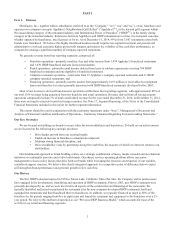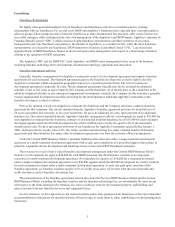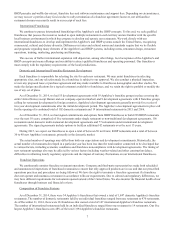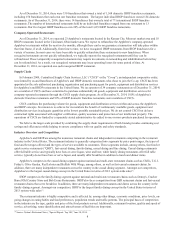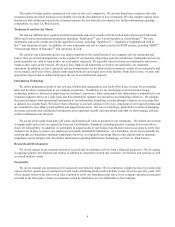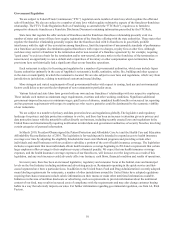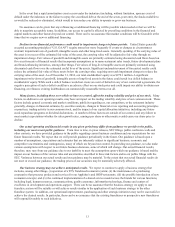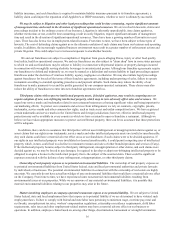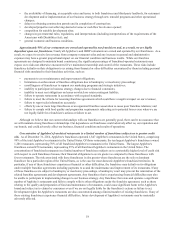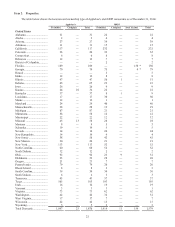IHOP 2014 Annual Report Download - page 32
Download and view the complete annual report
Please find page 32 of the 2014 IHOP annual report below. You can navigate through the pages in the report by either clicking on the pages listed below, or by using the keyword search tool below to find specific information within the annual report.13
In the event that a rapid amortization event occurs under the indenture (including, without limitation, upon an event of
default under the indenture or the failure to repay the securitized debt at the end of the seven-year term), the funds available to
us would be reduced or eliminated, which would in turn reduce our ability to operate or grow our business.
No assurance can be given that any refinancing or additional financing will be possible when needed or that we will be
able to negotiate acceptable terms. In addition, our access to capital is affected by prevailing conditions in the financial and
capital markets and other factors beyond our control. There can be no assurance that market conditions will be favorable at the
times that we require new or additional financing.
Declines in our financial performance could result in impairment charges in future periods. United States generally
accepted accounting principles (“U.S. GAAP”) require annual (or more frequently if events or changes in circumstances
warrant) impairment tests of goodwill, intangible assets and other long-lived assets. Generally speaking, if the carrying value of
the asset is in excess of the estimated fair value of the asset, the carrying value will be adjusted to fair value through an
impairment charge. Fair values of goodwill and intangible assets are primarily estimated using discounted cash flows based on
five-year forecasts of financial results that incorporate assumptions as to same-restaurant sales trends, future development plans
and brand-enhancing initiatives, among other things. Fair values of long-lived tangible assets are primarily estimated using
discounted cash flows over the estimated useful lives of the assets. Significant underachievement of forecasted results could
reduce the estimated fair value of these assets below the carrying value, requiring non-cash impairment charges to reduce the
carrying value of the asset. As of December 31, 2014, our total stockholders' equity was $279.1 million. A significant
impairment write-down of goodwill, intangible assets or long-lived assets in the future could result in a deficit balance in
stockholders' equity. While such a deficit balance would not create an event of default in any of our contractual agreements, the
negative perception of such a deficit could have an adverse effect on our stock price and could impair our ability to obtain new
financing, or refinance existing indebtedness on commercially reasonable terms or at all.
Many factors, including those over which we have no control, affect the trading volatility and price of our stock. Many
factors, in addition to our operating results, may have an impact on the trading volatility and price of our common stock. These
factors include general economic and market conditions, publicity regarding us, our competitors, or the restaurant industry
generally, changes in financial estimates by securities analysts, changes in financial or tax reporting and accounting principles
or practices, trading activity in our common stock, and the impact of our capital allocation initiatives, including any future
stock repurchase programs or dividend declarations. A number of these factors are outside of our control, and any failure to
meet market expectations whether for sales growth rates, earnings per share or other metrics could cause our share price to
decline.
Our actual operating and financial results in any given period may differ from guidance we provide to the public,
including our most recent public guidance. From time to time, in press releases, SEC filings, public conference calls and
other contexts, we have provided guidance to the public regarding current business conditions and our expectations for our
future financial results. We expect that we will provide guidance periodically in the future. Our guidance is based upon a
number of assumptions, expectations and estimates that are inherently subject to significant business, economic and
competitive uncertainties and contingencies, many of which are beyond our control. In providing our guidance, we also make
various assumptions with respect to our future business decisions, some of which will change. Our actual financial results,
therefore, may vary from our guidance due to our inability to meet the assumptions upon which our guidance is based and the
impact on our business of the various risks and uncertainties described in these risk factors and in our public filings with the
SEC. Variances between our actual results and our guidance may be material. To the extent that our actual financial results do
not meet or exceed our guidance, the trading prices of our securities may be materially adversely affected.
Our business strategy may not achieve anticipated results. We expect to continue to apply a business strategy that
includes, among other things, (i) operation of a 99% franchised restaurant system; (ii) the maintenance of a purchasing
cooperative that procures products and services for our Applebee's and IHOP restaurants; (iii) the possible introduction of new
restaurant concepts; and (iv) the continued implementation of a shared service model across the brands for various functions,
including legal, human resources, communications, quality assurance, information technology, finance and centers of
excellence in development and operations support. There can be no assurance that the business strategy we apply to one
franchise system will be suitable or will achieve results similar to the application of such business strategy to the other
franchise system. In addition, our operational improvement, purchasing and other strategic initiatives may not be successful or
achieve the desired results. In particular, there can be no assurance that the existing franchisees or prospective new franchisees
will respond favorably to such initiatives.


